Harney Peak

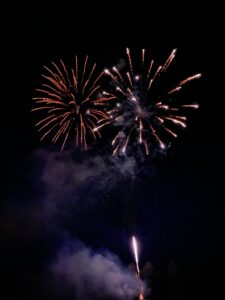 Every year, around the time of my husband, Bob Schulenberg’s birthday and also around the 4th of July, Bob and I take our annual hiking trip to the Black Hills. We aren’t always there on Bob’s birthday, which is six days after the 4th of July, and so doesn’t always fall conveniently in the same week. Nevertheless, we celebrate his birthday too, with time together as a couple, doing one of the activities we both have loved to do for years…hiking. It hasn’t always been easy for either of us to hike some of the more difficult trails, and one year, Bob’s back was so out of place, that even the easiest of trails was more than he could handle. That was a rough year. We went to the Black Hills and spent a lot of time in a motel room.
Every year, around the time of my husband, Bob Schulenberg’s birthday and also around the 4th of July, Bob and I take our annual hiking trip to the Black Hills. We aren’t always there on Bob’s birthday, which is six days after the 4th of July, and so doesn’t always fall conveniently in the same week. Nevertheless, we celebrate his birthday too, with time together as a couple, doing one of the activities we both have loved to do for years…hiking. It hasn’t always been easy for either of us to hike some of the more difficult trails, and one year, Bob’s back was so out of place, that even the easiest of trails was more than he could handle. That was a rough year. We went to the Black Hills and spent a lot of time in a motel room.
This year was one of the good years…at least in how Bob felt. 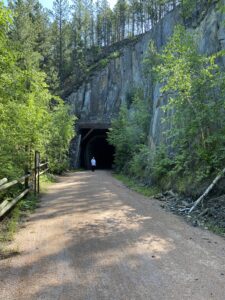
 We weren’t hiking any of the real difficult trails, especially our favorite…Harney Peak (now Black Elk Peak), but we hiked every day, even though it was cold this year and rained almost every day. This has just been a strange summer, and one I haven’t exactly enjoyed to this point, but since the temperatures are moving up, so are the prospects of summertime fun. Now, getting Bob to take time off to from the work he does from home…that’s not so easy.
We weren’t hiking any of the real difficult trails, especially our favorite…Harney Peak (now Black Elk Peak), but we hiked every day, even though it was cold this year and rained almost every day. This has just been a strange summer, and one I haven’t exactly enjoyed to this point, but since the temperatures are moving up, so are the prospects of summertime fun. Now, getting Bob to take time off to from the work he does from home…that’s not so easy.
Bob is a mechanic, and when he retired, he really didn’t intend to “retire” exactly. He just didn’t want to go to work and be on someone else’s schedule. He loves being a mechanic, but he wants to work on the jobs he wants to, on his schedule, and from his own garage. He likes the idea of just going out there whenever he wants to, and taking a 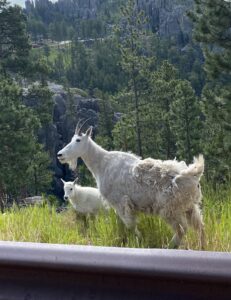
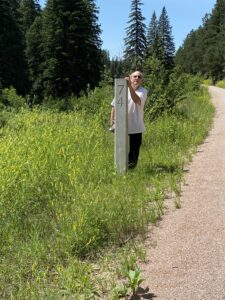 break whenever he wants to. Don’t get me wrong, Bob will take most jobs, provided he has the time and ability to do the job. Also, he will pretty much work a job until it is done, unless it is one that is obviously going to take several days. Still, he just likes being in control of his days, weeks, and life in general. And he is so much happier these days. He feels better, even though some days his back hurts from being bent over a car. And he is able to take some time and just go for an evening walk with me…which I like very much. The life of a semi-retired, self-employed mechanic suits him to a “t” so I’m happy. Today is Bob’s 69th birthday. Wow!! It doesn’t seem he is 69 at all. Happy birthday Bob!! Have a great day!! We all love you very much…but especially me!!!
break whenever he wants to. Don’t get me wrong, Bob will take most jobs, provided he has the time and ability to do the job. Also, he will pretty much work a job until it is done, unless it is one that is obviously going to take several days. Still, he just likes being in control of his days, weeks, and life in general. And he is so much happier these days. He feels better, even though some days his back hurts from being bent over a car. And he is able to take some time and just go for an evening walk with me…which I like very much. The life of a semi-retired, self-employed mechanic suits him to a “t” so I’m happy. Today is Bob’s 69th birthday. Wow!! It doesn’t seem he is 69 at all. Happy birthday Bob!! Have a great day!! We all love you very much…but especially me!!!
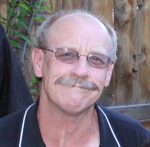
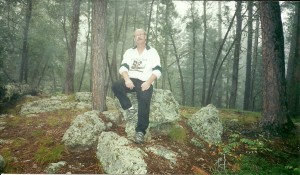 My husband, Bob Schulenberg and I love to hike the Black Hills, and with Independence Day and Bob’s birthday on July 10th, it is always a perfect time for us to go and spend a week in one of the places we love the most. We aren’t always able to hike our favorite trail, up to Harney Peak (now called Black Elk Peak), because sometimes, one or the other of us isn’t in shape for it. We always miss that hike when we are unable to go there and look forward to getting “back in the saddle” again, so to speak. It’s not that we ride the trails on horseback, but it might be one way to get up there in a
My husband, Bob Schulenberg and I love to hike the Black Hills, and with Independence Day and Bob’s birthday on July 10th, it is always a perfect time for us to go and spend a week in one of the places we love the most. We aren’t always able to hike our favorite trail, up to Harney Peak (now called Black Elk Peak), because sometimes, one or the other of us isn’t in shape for it. We always miss that hike when we are unable to go there and look forward to getting “back in the saddle” again, so to speak. It’s not that we ride the trails on horseback, but it might be one way to get up there in a 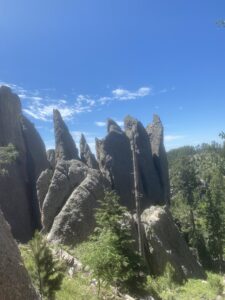
 pinch. I think I might have to consider that option, if it is too many years before we can get back up there.
pinch. I think I might have to consider that option, if it is too many years before we can get back up there.
After being together for more than 48 years, married for just over 47 years, we are comfortable in our life. We are one of the forever marriages, and that means that we must like doing many of the same things. It stands to reason, and we find ourselves thinking and acting alike. The same activities are fun for both of us, and yes…we can finish each other’s sentences. It is almost impossible not to. That’s what long term married couples do. They just know each other, and how their mate would react to things. That is the case with my husband and me. We are soulmates, and that is perfectly ok with us.
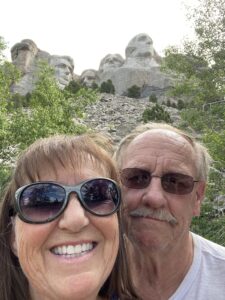
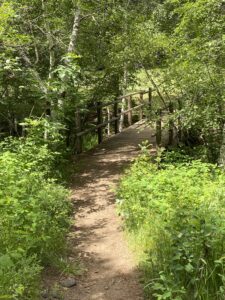 Bob spends much of his free time working on vehicles, for us and his friends. Thats a good thing, because he would probably go just a little crazy without his favorite pastime to keep him busy. Bob loves working on cars, and he is very good at it. He has a knack for finding out what is wrong with a vehicle and then fixing it. What would drive someone else crazy, keeps his mind sharp and on track. Mechanics is like a puzzle for him. Every piece has its proper place and finding that proper place is his passion…and the people whose vehicles he works on, reap the benefits. And they consider themselves blessed. Today is Bob’s birthday. Happy birthday Bob!! You are the love of my life, and I am so blessed to be your wife. Have a great day!! We love you!!
Bob spends much of his free time working on vehicles, for us and his friends. Thats a good thing, because he would probably go just a little crazy without his favorite pastime to keep him busy. Bob loves working on cars, and he is very good at it. He has a knack for finding out what is wrong with a vehicle and then fixing it. What would drive someone else crazy, keeps his mind sharp and on track. Mechanics is like a puzzle for him. Every piece has its proper place and finding that proper place is his passion…and the people whose vehicles he works on, reap the benefits. And they consider themselves blessed. Today is Bob’s birthday. Happy birthday Bob!! You are the love of my life, and I am so blessed to be your wife. Have a great day!! We love you!!
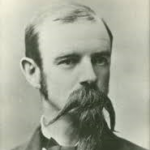
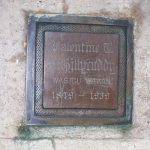
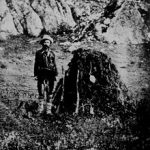 Valentine Trant O’Connell McGillycuddy was born on February 14, 1849 in Racine, Wisconsin to Irish immigrants Daniel McGillycuddy (1821–1892), a merchant, and Joana (Trant) McGillycuddy (1813–1892). His brother, Francis was 6 years older than he was. The McGillycuddy family moved to Detroit when Valentine was 13. At 20 years of age, McGillycuddy graduated from the Detroit Medical School. He began working as a doctor at the Wayne County Insane Asylum and practiced medicine for one year, a job that nearly drove him crazy…literally. Next, he began teaching at the medical college. His longstanding love for the outdoors eventually led McGillycuddy to leave the city medical field. At the request of Army engineer, General Cyrus Comstock, McGillycuddy surveyed and mapped the Great Lakes and Chicago’s devastation after the Great Fire. He probably could have stayed and continued working for the Army in the Great Lakes area, but his heart was in the West.
Valentine Trant O’Connell McGillycuddy was born on February 14, 1849 in Racine, Wisconsin to Irish immigrants Daniel McGillycuddy (1821–1892), a merchant, and Joana (Trant) McGillycuddy (1813–1892). His brother, Francis was 6 years older than he was. The McGillycuddy family moved to Detroit when Valentine was 13. At 20 years of age, McGillycuddy graduated from the Detroit Medical School. He began working as a doctor at the Wayne County Insane Asylum and practiced medicine for one year, a job that nearly drove him crazy…literally. Next, he began teaching at the medical college. His longstanding love for the outdoors eventually led McGillycuddy to leave the city medical field. At the request of Army engineer, General Cyrus Comstock, McGillycuddy surveyed and mapped the Great Lakes and Chicago’s devastation after the Great Fire. He probably could have stayed and continued working for the Army in the Great Lakes area, but his heart was in the West.
In 1875 he joined the US Geological Survey sponsored Newton-Jenney Expedition to the Black Hills. This trip would set the course for the rest of his life. Part scientific exploration, part treasure hunt, the expedition was fueled by the trip George Armstrong Custer made into the land of the Lakota and the reports of gold he brought back. Following that trip, McGillycuddy was appointed as the Army surgeon at Nebraska’s Fort Robinson and later administrator at Nebraska’s Red Cloud Agency in 1877. That appointment led to a friendship with Crazy Horse, and antipathy toward Red Cloud, both powerful leaders of the Dakota plains.
McGillycuddy had an uncanny knack for being at the right place at the right time, which put him right in the middle of things during the most consequential era of the American frontier. He met, treated, befriended, or opposed some of its most iconic figures including Little Big Horn principals, George Armstrong Custer, General George Crook, and Major Mark Reno, as well as Buffalo Bill Cody, Wild Bill Hickok, Calamity Jane Canary, the legendary Sioux chiefs Sitting Bull and American Horse, and John Wesley Powell…the man who mapped the Grand Canyon.
It also placed him squarely in the middle of a deadly struggle between the young upstart, Crazy Horse and the dominant chief of the Oglala Lakota, Red Cloud. The two were on different sides of just about everything. Crazy Horse resisted Anglo-American incursion at every turn, taking part in nearly every important battle including the Little Big Horn and the subsequent Dakota War. Red Cloud, who signed the 1851 Treaty of Fort Laramie, was deeply disappointed in the outcome. After having his own war named for him, Red Cloud’s War of 1866, he was finally willing to go along to get along. He and his band settled on the reservation, where he squabbled with Dr John J Saville, the government’s agency man.
McGillycuddy was at Fort Robinson when Crazy Horse surrendered in 1877. The move may have partially been prompted by his wife’s illness. McGillycuddy successfully treated Black Shawl. Some say she had tuberculosis and others claim it was cholera, which killed her three-year-old daughter. Whatever her ailment, saving her life brought about a close bond between Crazy Horse and the doctor. Six months after he surrendered, Crazy Horse was dead. Many people think he was assassinated, stirring a controversy that remains unresolved to this day. McGillycuddy spent the the wounded Crazy Horse’s last hours at his bedside. Varying accounts of the incident were provided by eye witnesses. Army Private William Gentles, an Irish immigrant soldier with a sketchy military career is a prime candidate for the killing of Crazy Horse, stabbing him with a bayonet. The Army’s retelling has Crazy Horse challenging the guards with two concealed knives as they attempted to lock him up, however. In the struggle, he fell on his own weapon. This version was attributed to Charging Bear, the real life “Little Big Man.” He is depicted as either a Crazy Horse lieutenant and “Shirt Wearer,” or a jealous rival who sought to curry favor with his Army captors. A number of Lakota genealogists lean heavily toward the latter, describing him as manipulative. He received a medal for his involvement in the incident.
McGillycuddy certified that his friend, Crazy Horse died near midnight on September 5, 1877, saying his killing “absolutely inexcusable.” Little Big Man was just part of the conspiracy. Crazy Horse was surrounded by shadowy characters. French and Lakota translator, William Garnett, thought that Little Big Man was the killer, but more than a dozen witnesses say an Army guard, perhaps Gentles, stabbed Crazy Horse. In the aftermath, Garnett was labeled a spy. Supposedly Garnett had no connection to Red Cloud, but Nellie Larrabee did. It was speculated that perhaps married to Crazy Horse, Larrabee, known as Chi Chi and Brown Eyed Woman, was sent to the Crazy Horse, Black Shawl household by Red Cloud. It was thought that she was there to act as a spy. Red Cloud was definitely not a fan of Crazy Horse. He thought his resistance to US forces was detrimental to the Lakota cause, but Red Cloud may have also been jealous of the attention the Army gave him. And then things got complicated. Red Cloud and Spotted Tail, a relative of Black Shawl, joined forces against the government’s attempts to seize tribal lands. Spotted Tail approved the Fort Laramie Treaty but continued to fight for sovereignty when the terms of the treaty were not met. Like Red Cloud, he believed it was a fool’s errand to oppose the government on the battlefield.
Along with Garnett, many Lakota deeply mistrusted Larrabee, calling her an “evil woman,” who helped lead Crazy Horse into a “domestic trap” that eventually caused his downfall and placed Spotted Tail in a Red Cloud conspiracy, as well. Others say Spotted Tail was unaware of any plot against Crazy Horse. After Crazy Horse died, McGillycuddy was named the Indian Agent on the Pine Ridge. His old enemy, Red Cloud had a hand to his downfall, accusing him of mismanagement and wrongdoing. A number of investigations were launched into the claims. Still McGillycuddy did his job, and amid charges of “tyranny” and fraud, he established a reservation police force and a boarding school. The breaking point came when the doctor was ordered to fire an otherwise blameless clerk. Rather than do so, he resigned his position in October of 1882 and moved with his wife Frances “Fanny” (Hoyt) McGillycuddy to Rapid City.
It was the end of an era. McGillycuddy served as Dean of the South Dakota School of Mines and Technology and was appointed South Dakota’s first State Surgeon. He was elected Rapid City mayor in 1897, but when Fanny died, he moved to California. Later, he married Julia Blanchard and enlisted at the start of World War I, serving Alaska and the western states during the 1918 Spanish Flu pandemic. His nemesis, Red Cloud, the last and one of the best known Lakota leaders, outlived nearly all of them. He died on the Pine Ridge Reservation, December 10, 1909 at 87 after converting to Christianity. He claimed the government had made many promises, but kept only one, saying, “They promised to take our land…and they took it.” There are 128 known photographs of Red Cloud, none of Crazy Horse, save a latter-day image found in a derelict photo studio in Chadron, Nebraska. It is still unverified. Black Shawl died in 1927, presumably of influenza. Helen “Nellie” Larrabee is believed to have died in about 1880. One source lists her burial in Charles Mix County near the present day Lake Andes, South Dakota.
Valentine McGillycuddy died on June 6, 1939, at the age of 90. Flags were lowered to half staff on the Pine Ridge at the news of his passing and his ashes were interred on Black Elk Peak in the Black Hills. Formerly known as Harney Peak, he had scaled the mountain as a young surveyor with the Newton-Jenney expedition. A simple stone monument reads “Valentine T. McGillycuddy, Wasicu Wakan, (Holy White Man) 1849-1939.” 

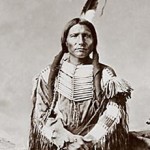 Valentine McGillycuddy’s grave site, Custer State Park, South Dakota, is accessible only by hiking trails, the most commonly used is Trail No. 9, from the Sylvan Lake Day Use Area. It is a site my husband, Bob and I have visited 15 times over the years. The three-mile hike through the ponderosa pine leads to the former fire tower atop what is now Black Elk Peak.
Valentine McGillycuddy’s grave site, Custer State Park, South Dakota, is accessible only by hiking trails, the most commonly used is Trail No. 9, from the Sylvan Lake Day Use Area. It is a site my husband, Bob and I have visited 15 times over the years. The three-mile hike through the ponderosa pine leads to the former fire tower atop what is now Black Elk Peak.

 As our vacation comes the an end, I found myself contemplating a few things about the Black Hills, and why we love them so much. Of course, Harney Peak (now renamed Black Elk Peak, but always Harney Peak in my mind) is our favorite hike, and one we have hiked 16 times now. As we were driving to Keystone to catch the 1880 Train, which is our last day of vacation tour every year, I can get a glimpse of Harney Peak, and it occurred to me that I might be much the same as Doctor Valentine Trant O’Connell McGillycuddy, the white man whose ashes are entombed at the top of the peak at the fire tower there. McGillycuddy was the first white man ever to climb Harney Peak. And when he was an Indian Agent, he was respected and even called “Tasunka Witko Kola” (Crazy Horse’s friend), because he was of course, Crazy Horse’s friend, but was also loved and respected by all of the Lakota Sioux tribe. As a doctor, he treated Crazy Horse’s wife, which brought about their lifelong friendship. He also treated many other Lakota Sioux warriors when they were wounded in a wrongful attack by the army. To the Lakota Sioux, even his old enemy, Red Cloud, McGillycuddy was known as “Wasicu Wakan,” which literally means Holy White Man. It was probably the greatest sign of respect he could have received. Now I’m not saying that I could even begin to compare to McGillycuddy in all the things he did, but in one way, we are the same. We both love the Black Hills, and especially Harney Peak. After McGillycuddy passing, and as a show of respect, and to commemorate his love of the Black Hills and Harney Peak, his ashes were entombed in that amazing place.
As our vacation comes the an end, I found myself contemplating a few things about the Black Hills, and why we love them so much. Of course, Harney Peak (now renamed Black Elk Peak, but always Harney Peak in my mind) is our favorite hike, and one we have hiked 16 times now. As we were driving to Keystone to catch the 1880 Train, which is our last day of vacation tour every year, I can get a glimpse of Harney Peak, and it occurred to me that I might be much the same as Doctor Valentine Trant O’Connell McGillycuddy, the white man whose ashes are entombed at the top of the peak at the fire tower there. McGillycuddy was the first white man ever to climb Harney Peak. And when he was an Indian Agent, he was respected and even called “Tasunka Witko Kola” (Crazy Horse’s friend), because he was of course, Crazy Horse’s friend, but was also loved and respected by all of the Lakota Sioux tribe. As a doctor, he treated Crazy Horse’s wife, which brought about their lifelong friendship. He also treated many other Lakota Sioux warriors when they were wounded in a wrongful attack by the army. To the Lakota Sioux, even his old enemy, Red Cloud, McGillycuddy was known as “Wasicu Wakan,” which literally means Holy White Man. It was probably the greatest sign of respect he could have received. Now I’m not saying that I could even begin to compare to McGillycuddy in all the things he did, but in one way, we are the same. We both love the Black Hills, and especially Harney Peak. After McGillycuddy passing, and as a show of respect, and to commemorate his love of the Black Hills and Harney Peak, his ashes were entombed in that amazing place.
Of course, for us there are many special places in the Black Hills. We love the trails. Among our favorites are, of course, Harney Peak, Sunday Gulch, Horsethief Lake, Cathedral Spires, the Flume Trail, the Mickelson, the Centennial, and French Creek trails. These trails take us to beautiful areas of the Hills that you just can’t see from the road. They are inside places like the Black Elk Wilderness areas. These are remote places where you 
 have to sign in, just in cast you don’t come back out. It gives them a place to start looking for you. In reality, it would be hard to get lost, provided you stay on the trail. The trails are well marked and easy to spot. It’s just not easy to get lost. Some of the trails are really hard, however, and sometimes it just depends on the shape you’re in. A trail that was really hard one year can be a lot more tolerable the next year. The Black Hills are a challenge, at least for the tourist who gets away from the touristy things, and looks for the remote beauty of the Black Hills.
have to sign in, just in cast you don’t come back out. It gives them a place to start looking for you. In reality, it would be hard to get lost, provided you stay on the trail. The trails are well marked and easy to spot. It’s just not easy to get lost. Some of the trails are really hard, however, and sometimes it just depends on the shape you’re in. A trail that was really hard one year can be a lot more tolerable the next year. The Black Hills are a challenge, at least for the tourist who gets away from the touristy things, and looks for the remote beauty of the Black Hills.

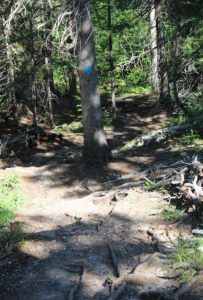 After a spring filled with pneumonia for my husband, Bob and bronchitis for me, our annual hiking trip to the Black Hills of South Dakota was in question. Not the trip itself really, but the normal amount of hiking that we do, and the trails we normally take. We had determined that our favorite trail, up to Harney Peak was simply out of the question, and our early hikes were the Willow Creek trail, and two days on the Mickelson trail, both considered easy trails. We did exceptionally well, and so we decided that today would be a day for a moderate trail. We used the AllTrails app to make our decision, and settled on the Sunday Gulch trail, which takes off from Sylvan Lake.
After a spring filled with pneumonia for my husband, Bob and bronchitis for me, our annual hiking trip to the Black Hills of South Dakota was in question. Not the trip itself really, but the normal amount of hiking that we do, and the trails we normally take. We had determined that our favorite trail, up to Harney Peak was simply out of the question, and our early hikes were the Willow Creek trail, and two days on the Mickelson trail, both considered easy trails. We did exceptionally well, and so we decided that today would be a day for a moderate trail. We used the AllTrails app to make our decision, and settled on the Sunday Gulch trail, which takes off from Sylvan Lake.
When we got to the trailhead, the sign said that it was a strenuous trail that was four miles long and was expected to take two to three hours to complete. The trail’s rating made us hesitate, but we decided that if it got too rough, we would turn around and head back. We began the trail with a down hill hike across the rocks, with handrails to keep you from slipping. Yes…it was that difficult. My instincts said, “Maybe this isn’t such a good idea.” But, insanity won out, and we pressed on. The 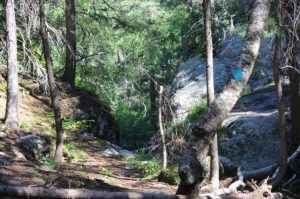
 trail was beautiful, and the air was cool down in the gulch, despite the 90° temperatures up above. We had started the hike early enough, and expected to be done by 11:30am. As we continued down, using several handrails to cross the difficult rocks, I just kept hoping that we didn’t have to go back up those rocks.
trail was beautiful, and the air was cool down in the gulch, despite the 90° temperatures up above. We had started the hike early enough, and expected to be done by 11:30am. As we continued down, using several handrails to cross the difficult rocks, I just kept hoping that we didn’t have to go back up those rocks.
After what we now know to be the last of the handrails, we came across the first people we would see. The were a young couple who told us the were beginning hikers. We asked if they had hiked this trail before. They had not, but they told us that the trail ahead was a gradual uphill hike…mostly anyway…with no handrails. My mind felt instant relief. It was short lived. Yes, the hike was a gradual uphill…some of the way, and no, there were no handrails. That doesn’t mean that the hike was easy. Granted we were not in the same shape we had been in years past, but I had hoped 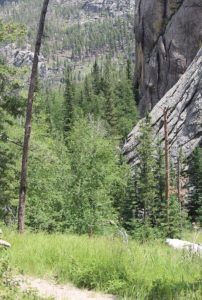
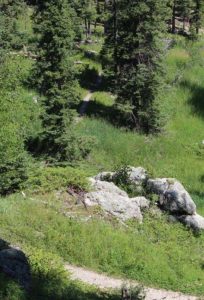 that we were in better shape than it seemed we were. The 11:30am mark came and went, with us being apparently no closer to the end of the trail. We were close to the road at times, but there was no guarantee that it would be an easier hike. As we climbed I thought about two things. First, I had probably chosen a trail that was too hard for us. Second, that we were actually more that three quarters of the way through that trail, and while we were tired, we were making it. We were making it!! When we finally reached the end of the trail at 12:30pm, we felt a sense of pride in our accomplishment. We had broken through a barrier, and we made it back. It was the most strenuous, moderate trail we have ever hiked, but we did it, it was beautiful…and that’s what it’s all about.
that we were in better shape than it seemed we were. The 11:30am mark came and went, with us being apparently no closer to the end of the trail. We were close to the road at times, but there was no guarantee that it would be an easier hike. As we climbed I thought about two things. First, I had probably chosen a trail that was too hard for us. Second, that we were actually more that three quarters of the way through that trail, and while we were tired, we were making it. We were making it!! When we finally reached the end of the trail at 12:30pm, we felt a sense of pride in our accomplishment. We had broken through a barrier, and we made it back. It was the most strenuous, moderate trail we have ever hiked, but we did it, it was beautiful…and that’s what it’s all about.
 In my many hikes to the Harney Peak lookout, I have noticed many times the marker there for Dr Valentine McGillycuddy. I suppose that the main reason it has stuck in my head is because of my grandfather, George Byer, who used to call our house and ask for Mrs McGillycuddy. We always knew it was Grandpa, but we went along with the joke anyway. Of course, Grandpa’s Mrs McGillycuddy was fictional, while Valentine McGillycuddy was a real person. I did some research a few years ago, and found out that Valentine McGillycuddy was the first white man to climb all the way to the top of Harney Peak. Many have followed in his footsteps, myself and my husband included. Harney Peak, so named in the late 1850s by Lieutenant Gouverneur K. Warren in honor of General William S. Harney, who was commander of the military in the Black Hills area. The Lakota Sioux Indians called it Hinhan Kaga, which means “Making of Owls” in English. I think I like that name.
In my many hikes to the Harney Peak lookout, I have noticed many times the marker there for Dr Valentine McGillycuddy. I suppose that the main reason it has stuck in my head is because of my grandfather, George Byer, who used to call our house and ask for Mrs McGillycuddy. We always knew it was Grandpa, but we went along with the joke anyway. Of course, Grandpa’s Mrs McGillycuddy was fictional, while Valentine McGillycuddy was a real person. I did some research a few years ago, and found out that Valentine McGillycuddy was the first white man to climb all the way to the top of Harney Peak. Many have followed in his footsteps, myself and my husband included. Harney Peak, so named in the late 1850s by Lieutenant Gouverneur K. Warren in honor of General William S. Harney, who was commander of the military in the Black Hills area. The Lakota Sioux Indians called it Hinhan Kaga, which means “Making of Owls” in English. I think I like that name.
Dr McGillycuddy first came to the Black Hills with the Jenny-Newton Party. His mission was to survey and map 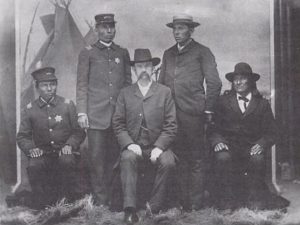
 the Black Hills, and to confirm that gold had been discovered there. It was during this excursion that he climbed Harney Peak. There had been other white men to climb the mountain, including General George Custer, but they all stopped just short of the peak, because it was to difficult to make it…something I think I can relate to. McGillycuddy angled a felled tree into a crevice in the granite, and made his way to the very top. I can totally feel his elation and sense of accomplishment, since I have felt the same way myself. My guess is that it would not be the last trip he made to the top either. That mountain has a way of calling you back for a second and even third or more visits.
the Black Hills, and to confirm that gold had been discovered there. It was during this excursion that he climbed Harney Peak. There had been other white men to climb the mountain, including General George Custer, but they all stopped just short of the peak, because it was to difficult to make it…something I think I can relate to. McGillycuddy angled a felled tree into a crevice in the granite, and made his way to the very top. I can totally feel his elation and sense of accomplishment, since I have felt the same way myself. My guess is that it would not be the last trip he made to the top either. That mountain has a way of calling you back for a second and even third or more visits.
McGillycuddy became a friend to Crazy Horse, and in fact was with him when he died after being stabbed at Fort Robinson, Nebraska in 1877. After that time, the Lakota Sioux named McGillycuddy Tasunka Witko Kola,  which means “Crazy Horse’s Friend” in English. Other Native Americans named McGillycuddy Wasicu Wakan, which means “Holy White Man” in English. Dr Valentine McGillycuddy did lead a very amazing life. His first wife died, and he moved to San Francisco to continue his medical practice. There he married Julia Blanchard. After he passed away in 1939, Julia wrote a book about his life called “McGillycuddy, Agent” which was how he signed his name during his favorite role in life. He was a friend to the Indians, and did his best to educate them by building a school for the children. He was a calming influence on the relationship between the Indians and the White Man. It is quite fitting then that his ashes be entombed on the mountain that he loved. It gives a totally different feeling to the little plaque that is there…if one researches it.
which means “Crazy Horse’s Friend” in English. Other Native Americans named McGillycuddy Wasicu Wakan, which means “Holy White Man” in English. Dr Valentine McGillycuddy did lead a very amazing life. His first wife died, and he moved to San Francisco to continue his medical practice. There he married Julia Blanchard. After he passed away in 1939, Julia wrote a book about his life called “McGillycuddy, Agent” which was how he signed his name during his favorite role in life. He was a friend to the Indians, and did his best to educate them by building a school for the children. He was a calming influence on the relationship between the Indians and the White Man. It is quite fitting then that his ashes be entombed on the mountain that he loved. It gives a totally different feeling to the little plaque that is there…if one researches it.

 Two years ago, my husband, Bob and I intended to take our favorite hike…Harney Peak in the Black Hills of South Dakota. That hike didn’t go so well, or at least we did not succeed in completing the full hike. The Lookout Tower eluded us in that, we reached it’s base, but could not go on to the top. The reasons were varied, but I felt like the main reason was that I was not in good enough shape for this tough trail. Bob thought otherwise, and looking back, I have to think that, at least in part, he was right. Bob thought that the heat of the day, combined with the lack of trees near the top since the pine beetle infestation, sapped our energy making it almost impossible to finish the hike. We had plenty of water, and food too, just no more energy…and we still had the 3.4 mile hike back staring us in the face.
Two years ago, my husband, Bob and I intended to take our favorite hike…Harney Peak in the Black Hills of South Dakota. That hike didn’t go so well, or at least we did not succeed in completing the full hike. The Lookout Tower eluded us in that, we reached it’s base, but could not go on to the top. The reasons were varied, but I felt like the main reason was that I was not in good enough shape for this tough trail. Bob thought otherwise, and looking back, I have to think that, at least in part, he was right. Bob thought that the heat of the day, combined with the lack of trees near the top since the pine beetle infestation, sapped our energy making it almost impossible to finish the hike. We had plenty of water, and food too, just no more energy…and we still had the 3.4 mile hike back staring us in the face.
After that hike, I wondered if I would be able to get myself back in shape for the next attempt. It was a low point in my hiking career. Six months ago, I made the decision that it was time to get back in shape, and to go after the Giant that had been looming over me for a year and a half. I started walking again and eating right, and before long I was doggedly walking 30,000 steps every day. Then shin splints hit me like a bomb. I was determined to continue walking so my training wouldn’t suffer, but after three weeks, I knew that I was going to have to do something different. Nevertheless, I tried to keep going, until my granddaughter, Shai Royce made me promise to take the next week off. Thankfully a week was all it took, and I was back to walking 25000 steps a day in a couple of weeks.
Still, the Giant loomed over me for the next month. Our trip was coming, and I wanted that mountain. The Harney Peak hike belonged to me. I have hiked it at least fifteen times over the last 21 years. I had 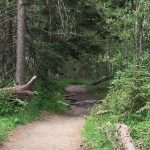
 paid my dues, and I did not want to let one bad experience take it away from me. We decided to head out to hike early…6:00am or so. In reality, we began our hike 6:37am, and with the light cloud cover and the earliness of our hiking time, we were very comfortable. The hike was hard…it always is, but in two and a half hours, we found ourselves at the top standing in front of the lookout tower. We made it!! We had conquered the beast. The Giant no longer loomed over me. I know that there is no reason that I can’t continue to hike Harney Peak for years to come, because with hard work…there is nothing I can’t do.
paid my dues, and I did not want to let one bad experience take it away from me. We decided to head out to hike early…6:00am or so. In reality, we began our hike 6:37am, and with the light cloud cover and the earliness of our hiking time, we were very comfortable. The hike was hard…it always is, but in two and a half hours, we found ourselves at the top standing in front of the lookout tower. We made it!! We had conquered the beast. The Giant no longer loomed over me. I know that there is no reason that I can’t continue to hike Harney Peak for years to come, because with hard work…there is nothing I can’t do.
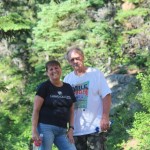
 After breaking my shoulder on October 18, 2015, in a fall on the Bridle Trail on Casper Mountain, I think a lot of people wondered if I would ever hike again, and if I did, if the Bridle Trail was going to be on the list of trails I liked best…or was even willing to hike on at all. I always knew that I would go on it again, but I got pretty out of shape in the months following the accident. For one thing, I found out that pain medications, make you gain weight, probably because they make you very hungry and very sleepy. And I’m sure there was a degree of depression about the injury, but I’m not one to let something get me down for very long. By January I was ready to get back into shape for hiking. My husband, Bob Schulenberg and I have loved hiking since 1995, when we first hiked Harney Peak in the Black Hills of South Dakota. It is a love of hiking that continues to grow. I wanted to get back into it, and I wanted to hike the Bridle Trail again.
After breaking my shoulder on October 18, 2015, in a fall on the Bridle Trail on Casper Mountain, I think a lot of people wondered if I would ever hike again, and if I did, if the Bridle Trail was going to be on the list of trails I liked best…or was even willing to hike on at all. I always knew that I would go on it again, but I got pretty out of shape in the months following the accident. For one thing, I found out that pain medications, make you gain weight, probably because they make you very hungry and very sleepy. And I’m sure there was a degree of depression about the injury, but I’m not one to let something get me down for very long. By January I was ready to get back into shape for hiking. My husband, Bob Schulenberg and I have loved hiking since 1995, when we first hiked Harney Peak in the Black Hills of South Dakota. It is a love of hiking that continues to grow. I wanted to get back into it, and I wanted to hike the Bridle Trail again.
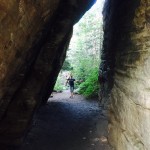
 Yesterday, I returned to the Bridle Trail to pick up where I left off in October. My granddaughter, Shai Royce has been hiking with her grandpa and me this summer, and she loves it. She never considered herself an outdoor girl, but she has since changed her mind. This past weekend, we hiked the Garden Creek Trail, and she loved it so much that she decided that she wanted to hike the Bridle Trail. Sunday was out of the question, so we decided that we would go Monday evening. Anyone who has ever hiked the Bridle Trail knows that the first half hour is the toughest. Nevertheless, while we had to stop to rest and catch our breath, we had a wonderful time. Shai thoroughly enjoyed it, and wants to go again, so we are making plans for several hikes before she moves to Washington in July.
Yesterday, I returned to the Bridle Trail to pick up where I left off in October. My granddaughter, Shai Royce has been hiking with her grandpa and me this summer, and she loves it. She never considered herself an outdoor girl, but she has since changed her mind. This past weekend, we hiked the Garden Creek Trail, and she loved it so much that she decided that she wanted to hike the Bridle Trail. Sunday was out of the question, so we decided that we would go Monday evening. Anyone who has ever hiked the Bridle Trail knows that the first half hour is the toughest. Nevertheless, while we had to stop to rest and catch our breath, we had a wonderful time. Shai thoroughly enjoyed it, and wants to go again, so we are making plans for several hikes before she moves to Washington in July.
For me, the hike was a victory in several ways. I can’t say that I didn’t get winded, but that is not unusual for me, and I hope to get my lungs in better shape for the hills in the future, but I did well with the hike, and there 
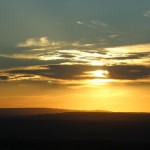
was no fear about the trail. We even went the same way we had gone when I fell, because I guess I felt like I needed to just get back on the horse that bucked me off, so that I could fully conquer the giant that could have formed in my life. The sooner you get back on that horse, the less chance fear has to take hold. I can now honestly say that since my return to the Bridle Trail…any concern that I might be afraid is totally gone, and I very much look forward to our next hike, and each subsequent hike on the Bridle Trail or any other trail. t was a lovely evening, and I still love hiking!!
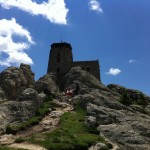 Sometimes, something we want can be almost within our grasp, but still slightly beyond our reach. That is such a frustrating place to be. Yesterday, Bob and I planned to hike Harney Peak in the Black Hills of South Dakota, and we did…in a way. The hike is 3.4 miles each way, and a lot of it takes you up some serious hills. We have not hiked like we used to in a couple of years, because we were very busy taking care of Bob’s parents, my mom, and Bob’s sister. We have been trying to get ready for hiking in the Black Hills this year, but we haven’t really reached a place where we feel like we are ready.
Sometimes, something we want can be almost within our grasp, but still slightly beyond our reach. That is such a frustrating place to be. Yesterday, Bob and I planned to hike Harney Peak in the Black Hills of South Dakota, and we did…in a way. The hike is 3.4 miles each way, and a lot of it takes you up some serious hills. We have not hiked like we used to in a couple of years, because we were very busy taking care of Bob’s parents, my mom, and Bob’s sister. We have been trying to get ready for hiking in the Black Hills this year, but we haven’t really reached a place where we feel like we are ready.
We hiked two really long sections of the Mickelson Trail the first two days of our trip, and yesterday was for Harney Peak. I think we both knew we weren’t really ready, but we thought we could do it…even if it took us a bit longer. Believe me, a bit was not even close to reality. We probably stopped triple the amount of times as normal. And breathing for me was…well, let’s just say I was gasping for air at times. I couldn’t believe I was that out of shape. But, the last time we dared take on Harney Peak was in 2011.
Nevertheless, we headed out…still tired from the day before, but hopeful that the day would bring success our way. It was a really tough go. I knew we were out of shape, but hoped that I was wrong about how bad it really was. As we walked and struggled, the truth was obvious. The one thing I can say, is that it was one of the hottest days here, so far this summer…but that is really the only excuse I have…and the one Bob agreed on and said we should use.
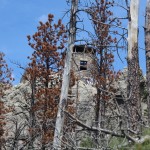
We did technically hike up Harney Peak, but when it came time to go up the 300 stairs, I has no more “up” in me. Bob could have made it, but he would not go without me. I was so hot and so tired that is wasn’t sure, at that moment, that I could make it back to the car, but I had to…there was no other way back, aside from life flight, and I wasn’t going there. We headed back and while it took us a while, we did make it back. We both agreed that we probably shouldn’t have attempted it, but in the end it was a successful failure. We did technically make it, we just didn’t go up the stairs to the very top. Does that make me feel better…no, but it is all I have.

 Bob and I are very much into hiking. We love hiking on different trails in the areas we travel to. Of course, our all time favorite place, so far, is the beautiful hike to Harney Peak in Custer State Park in the Black Hills of South Dakota, and we try to get up there every summer. We have also hiked the Southern Rim of The Grand Canyon in Arizona, and gone down into the canyon a little ways…that was beautiful too. Closer to home, we love the Bridle Trail that is located right here on Casper Mountain and the Platte River Parkway that meanders along the Platte River for almost 8 miles one way. Nevertheless, the reality is that you can’t always be on one of the beautiful trails, because there just isn’t time after work. So most evenings find us walking the city trail that is located a block from our house.
Bob and I are very much into hiking. We love hiking on different trails in the areas we travel to. Of course, our all time favorite place, so far, is the beautiful hike to Harney Peak in Custer State Park in the Black Hills of South Dakota, and we try to get up there every summer. We have also hiked the Southern Rim of The Grand Canyon in Arizona, and gone down into the canyon a little ways…that was beautiful too. Closer to home, we love the Bridle Trail that is located right here on Casper Mountain and the Platte River Parkway that meanders along the Platte River for almost 8 miles one way. Nevertheless, the reality is that you can’t always be on one of the beautiful trails, because there just isn’t time after work. So most evenings find us walking the city trail that is located a block from our house.
This trail just wanders along next to the alley between the houses from 2nd Street to 15th Street. We usually walk this one between 1 1/2 to 2 hours…thus walking between 6 and 8 miles a day. It isn’t a difficult trail, but it is a slight uphill grade going from north to south, and then a slight downhill grade going from south to north. It is a pleasant trail, and well traveled. We run into people we have never met, people we know only from the trail, and occasionally someone we know from the rest of our lives. But, these aren’t the only friends we run into one the trail…there are many others.
Many people are out walking their dogs in the evening, and while all these dogs are curious about us when we pass by, there are several that are quite special to us. They are all well behaved dogs, and they always come up to us and greet us with tails wagging, hoping that we will take a moment to pet them and talk with them. You really can’t resist, and these friends always understand that you are on a walk, and you can’t talk long, so after a friendly pat, they go merrily on down the trail looking for the next friendly encounter.
There are also the friends who are not on the trail. the dogs in the yards, wishing the could go with us. Some of them just bark at us for a couple of weeks, and then we become boring to them and we are ignored, but others are always there to greet us. Two of the most interesting dogs we pass are the two that are always on the roof of the homeowner’s garage. The deck connects to the detached garage in such a way that the dogs can run freely on the roof. The first time I saw it, I was shocked, but now it is just a normal…even if it is a little bit of a traffic stopper, site. Of course, we also see the birds, and occasionally a duck or two, and we encounter deer, rabbits, squirrels, and the occasional friendly pet cat.
All in all, while our walk on the trails are designed to be relaxing exercise, they really are filled with activity. We may not realize just how much activity there is going on around us all the 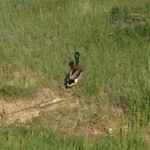
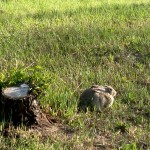
time, but it is there nevertheless. I always love late spring, summer, and early fall, because we have so many for opportunities to get out there on the trails then, and I really miss my trails in the late fall, winter, and early spring, because it is just too cold to get out and reconnect with nature. It’s funny that we have all these furry friends, because Bob and I choose not to have pets of our own. We are too busy. Still, I miss all of my furry trail friends when we are away.

